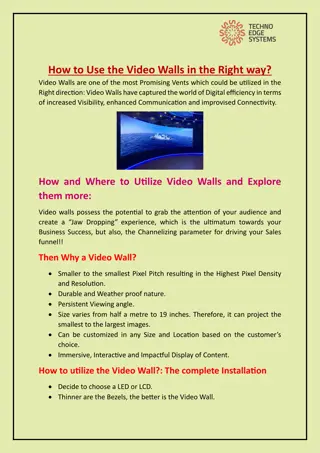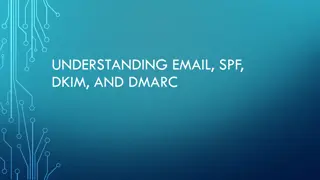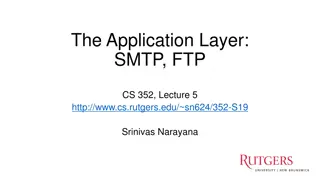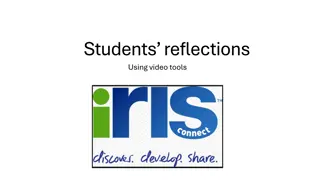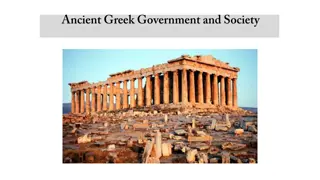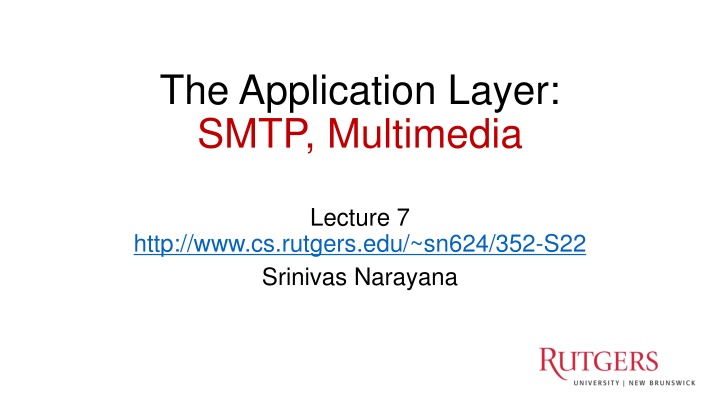
Mail Protocols: SMTP, POP3, IMAP4, and Web-Based Email
Explore the intricacies of mail protocols such as SMTP, POP3, IMAP4, and web-based email applications. Learn how these protocols enable communication and data exchange across mail servers and client devices. Gain insights into the differences between POP3 and IMAP4, as well as the integration of web-based email services with SMTP and HTTP.
Download Presentation

Please find below an Image/Link to download the presentation.
The content on the website is provided AS IS for your information and personal use only. It may not be sold, licensed, or shared on other websites without obtaining consent from the author. If you encounter any issues during the download, it is possible that the publisher has removed the file from their server.
You are allowed to download the files provided on this website for personal or commercial use, subject to the condition that they are used lawfully. All files are the property of their respective owners.
The content on the website is provided AS IS for your information and personal use only. It may not be sold, licensed, or shared on other websites without obtaining consent from the author.
E N D
Presentation Transcript
The Application Layer: SMTP, Multimedia Lecture 7 http://www.cs.rutgers.edu/~sn624/352-S22 Srinivas Narayana 1
Quick recap of concepts HyperText Transfer Protocol (HTTP) Origin s DNS CDN name servers Caching e.g., proxy server Content Distribution Networks Origin servers CDN servers Simple Mail Transfer Protocol (SMTP) Clients Recipient s mail server Sender s mail server SMTP Sender s user agent Recipient s user agent SMTP ??
Mail access protocols POP3 or IMAP4 SMTP SMTP access protocol user agent user agent Bob Alice receiver s mail server sender s mail server SMTP: delivery/storage to receiver s server. Focused on push Mail access protocol: pull from server POP: Post Office Protocol [RFC 1939] Client connects to POP3 server on TCP port 110 IMAP: Internet Mail Access Protocol [RFC 1730] Client connects to TCP port 143 HTTP: gmail, outlook, etc. 4
POP vs IMAP POP3 Stateless server UA-heavy processing UA retrieves email from server, then typically deleted from server Latest changes are at the UA Simple protocol (list, retr, del within a POP session) IMAP4 Stateful server UA and server processing Server sees folders, etc. which are visible to UAs Latest changes are at the server Complex protocol Heavily used: email sync across devices, reliable, 5
What about web-based email? Connect to mail servers via web browser Ex: gmail, scarletmail, etc. Browsers speak HTTP Email servers speak SMTP Need to bridge these two 6
Web based email Application process on the web server machine uses SMTP to push mail HTTP HTTP Alice alice@scarle tmail.rutger s.edu Bob HTTP server scarletmail.rut gers.edu HTTP server outlook.com App process on the web server uses access protocol to pull email May run on the same or different machines (owned by your webmail provider) SMTP Client/Server aspmx4.google mail.com SMTP server outlook- com.olc.protect ion.outlook.com Bob bob@outlook .com IMAP Internet Bob s mail provider s server(s) Alice s mail provider s server(s) 7
Comparing SMTP with HTTP HTTP: pull SMTP: push both have ASCII command/response interaction, status codes HTTP: each object encapsulated in its own response msg SMTP: multiple objects sent in multipart msg HTTP: can put non-ASCII data directly in response (dedicated entity body for binary data) SMTP: need ASCII-based encoding (base64) 8
More themes from app-layer protocols Keep it simple until you really need complexity Start with ASCII-based design; stateless servers. Then introduce: Cookies for HTTP state Stateful mail (IMAP, folders, etc.) for email organization Security extensions (e.g., HTTPS, IMAPS, SMTPS, ) Performance optimizations: persistence, caching, indirection, Use headers as much as possible to non-intrusively evolve functionality Partition functions based on what s done best at the user (app), protocol, and infrastructure. Examples: Content rendering for users (browser, UA) separate from protocol operations (mail server) Mail UAs don t need to be always on to send or receive email reliably. That s the mail server s job (an infrastructure concern) 9
Multimedia: Data Representations 10
Multimedia networking Many applications on the Internet use audio or video IP video traffic will be 82 percent of all IP traffic [ ] by 2022, up from 75 percent in 2017 CCTV traffic over the Internet will increase sevenfold between 2017 to 2022 Internet video to TV will increase threefold between 2017 to 2022. Consumer Video-on-Demand (VoD) traffic will nearly double by 2022 Source: Cisco visual networking index 2017--22 11
Whats different about these applications? Traditional applications (HTTP(S), SMTP) Delay tolerant but not loss tolerant Data used after transfer complete Multimedia applications are often real time Data delivery time during transfer matters for user experience Video/audio streaming Delay-sensitive Real-time audio and video Delays > 400 ms for audio is a bad user experience Somewhat loss tolerant 12
Digital representation of audio and video
Digital representation of audio Must convert analog signal to digital representation Sample How many times (twice the max frequency in the signal) Quantize How many levels or bits to represent each sample More levels more accuracy More levels more bits to store & need more bandwidth to transmit Compress Compact representation of quantized values 14
Audio representation analog audio signal sampled at constant rate telephone: 8,000 samples/sec CD music: 44,100 samples/sec each sample quantized, i.e., rounded e.g., 28=256 possible quantized values each quantized value represented by bits, e.g., 8 bits for 256 values quantization quantized value of analog value error audio signal amplitude analog signal time sampling rate (N sample/sec) 15
Audio representation example: 8,000 samples/sec, 256 quantized values Bandwidth needed: 64,000 bps quantization quantized value of analog value error audio signal amplitude analog signal receiver converts bits back to analog signal: some quality reduction time Example rates CD: 1.411 Mbps MP3: 96, 128, 160 Kbps Internet telephony: 5.3 Kbps and up sampling rate (N sample/sec) 16
Video representation Video: sequence of images displayed at constant rate e.g., 30 images/sec Appear continuous due to the stroboscopic effect frame i frame i+1 17
Video representation spatial coding example: instead of sending N values of same color (all purple), send only two values: color value (purple) and number of repeated values (N) Digital image: array of pixels each pixel represented by bits Encode luminance and color Number of pixels: resolution Coding: use redundancy within and between images to decrease # bits used to encode image spatial (within image) temporal (from one image to next) Coding/decoding algorithm often called a codec ... ... frame i temporal coding example: instead of sending complete frame at i+1, send only differences from frame i (motion vectors) frame i+1 18
Video codecs: terminology Video bit rate: effective number of bits per second of the video after encoding It depends on many factors Resolution of each image: more pixels = more bits Detail per pixel: better luminance & color detail = more bits Amount of movement in the video. More movement = more bits Quality of overall compression in the codec Video bit rate is typically correlated with quality of perception. Higher bit rate == better to perceive
Bit-rates: terminology Bit-rate of a video changes over the duration of the video CBR: (constant bit rate): fixed bit-rate video VBR: (variable bit rate): different parts of the video have different bit rates, e.g., changes in color, motion, etc. For VBR, we talk about average bit-rate over video s duration Examples of average video bit-rates MPEG 1 (CD-ROM) 1.5 Mbps. MPEG2 (DVD) 3-6 Mbps MPEG4 (often used in Internet, < 1 Mbps) In general, one Internet video stream takes up a few Mbit/s (unless HD) https://blog.video.ibm.com/streaming-video-tips/what-is-video-encoding-codecs-compression-techniques/
Networking multimedia: 3 types On-demand streamed video/audio Can begin playout before downloading the entire file Ful video/audio stored at the server: able to transmit faster than audio/video will be rendered (with storing/buffering at client) e.g., Spotify, YouTube, Netflix Conversationalvoice or video over IP interactive human-to-human communication limits delay tolerance e.g., Zoom, Google Stadia Live streamed audio, video e.g, sporting event on sky sports Can buffer a little, but must be close to the live edge of content
Streaming (stored) video Media is prerecorded at different qualities Available in storage at the server Client downloads an initial portion and starts viewing The rest is downloaded as time progresses No need for user to wait for entire content to be downloaded! Can change the quality of the content and where it s fetched mid-stream More on this soon
Streaming stored video Constant bit rate video Client e.g., your phone 2. video sent 1. video recorded (e.g., 30 frames/sec) 3. video received, played out at client (30 frames/sec) network delay (fixed in this example) time streaming: at this time, client playing out early part of video, while server still sending later part of video Server e.g. Netflix 24
Streaming stored video: challenges Continuous playout constraint: once client playout begins, playback must match the original timing of the video (why?) But network delays are variable! Clients have a client-side buffer of downloaded video to absorb variation in network conditions Client interactivity: pause, fast-forward, rewind, jump through video 25
Scenario 1: Constant bit-rate video constant bit rate video transmission client video reception constant bit rate video playout at client variable network delay buffered video time client playout delay Client-side buffering with playout delay: compensate for network-added delays and variations in the delay 26
Scenario 2: Small playout delay constant bit rate video transmission client video reception constant bit rate video playout at client variable network delay buffered video time client playout delay Playout delay that s too small can cause stalls There s nothing in the buffer to show to the user 27
Client-side buffering, playout buffer fill level, B(t) playout rate, e.g., CBR r variable fill rate, x(t) video server Client s buffer, size Bmax client Most video is broken up in time into multiple segments Client downloads video segment by segment For example: a segment might be 4 seconds worth of video. 28
Client-side buffering, playout buffer fill level, B(t) playout rate, e.g., CBR r variable fill rate, x(t) video server Client s buffer, size Bmax client 1. Initial fill of buffer until playout begins at tp 2. playout begins at tp 3. buffer fill level varies over time as fill rate x(t) varies (assume playout rate r is constant for now) 29
Client-side buffering, playout buffer fill level, B(t) playout rate, e.g., CBR r variable fill rate, x(t) video server Client s buffer, size Bmax playout buffering: average fill rate (x), playout rate (r): x < r: buffer eventually empties for a sufficiently long video. Stall and rebuffering x > r: buffer will not empty, provided the initial playout delay is large enough to absorb variability in x(t) initial playout delay tradeoff: buffer starvation less likely with larger delay, but also incur a larger delay until the user begins watching 30
Client-side buffering, playout buffer fill level, B(t) playout rate, e.g., CBR r variable fill rate, x(t) video server Client s buffer, size Bmax playout buffering: average fill rate (x), playout rate (r): is x < r or x > r for a given network connection? It is hard to predict this in general! Best effort network suffers long queues, paths with low bandwidth, How to set playout rate r? Too low a bit-rate r: video has poorer quality than needed Too high a bit-rate r: buffer might empty out. Stall/rebuffering! 31
Adaptive bitrate video Motivation: Want to provide high quality video experience, without stalls Observations: Videos come in different qualities (average bit rates) Versions of the video for different quality levels readily available Different segments of video can be downloaded separately Adapt bit rate per segment through collaboration between the video client (e.g., your browser) and the server (e.g., @ Netflix) Adaptive bit-rate (ABR) video: change the bit-rate (quality) of next video segment based on network and client conditions A typical strategy: Buffer-based rate adaptation
Buffer-based bit-rate adaptation Key idea: If there is a large stored buffer of video, optimize aggressively for video quality, i.e., high bit rates Else (i.e., buffer has low occupancy), avoid stalls by being conservative and ask for a lower quality (bit-rate) Hope: lower bandwidth requirement of a lower quality stream is satisfiable more easily
Buffer-based bit-rate adaptation A highly effective method to provide high video quality despite variable and intermittently poor network conditions. Used by Netflix. http://yuba.stanford.edu/~nickm/papers/sigcomm2014-video.pdf A Buffer-Based Approach to Rate Adaptation



